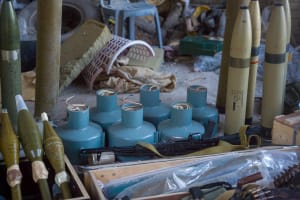IDF releases preliminary results of investigation into Rafah strike - IAF munitions not to blame for fire
Israeli military promises 'investigation will be swift, comprehensive and transparent'

IDF Spokesman Brig.-Gen. Daniel Hagari gave a press conference in English on Tuesday evening, where he reiterated that the Israeli military is investigating the causes of the fire that broke out after the Israeli Air Force (IAF) airstrike that killed two senior Hamas commanders on Sunday night.
In the briefing, Hagari said the IDF is also investigating the possibility that Hamas weapons stored in the area of the strike were responsible for causing the fire, which spread to an area of tents killing a number of civilians.
“On Sunday, we eliminated senior Hamas terrorists in a targeted strike, on a compound used by Hamas in Rafah,” Hagari said. “The strike was based on precise intelligence that indicated that these terrorists, who were responsible for orchestrating and executing terror attacks against Israelis, were meeting inside this structure we targeted.”
Hagari continued, “Sadly, following the strike, due to unforeseen circumstances, a fire ignited, taking the lives of Gazan civilians nearby. Despite our efforts to minimize civilian casualties during the strike, the fire that broke out was unexpected and unintended.”
Hagari called the deaths of Palestinian civilians a “devastating incident, which we did not expect.” According to the Hamas-run Gaza Health Ministry, 45 people were killed in the incident.
Hagari also presented satellite imagery from the site, saying the IDF “targeted a closed structure away from the tent area. There are no tents in the immediate vicinity.”
“Contrary to reports, we conducted the strike outside the area that we designated as a humanitarian area and called civilians to evacuate to. Our strike was over a kilometer and a half away from the al-Mawasi humanitarian area,” he noted, contradicting reports by the Palestinian Authority and some NGOs that the IAF had struck within al-Mawasi.

Hagari also denied reports that the IAF used a 2,000-pound bomb.
“The strike was conducted using two munitions with small warheads, suited for this targeted strike. We are talking about munitions with 17 kilograms (35 lbs) of explosive material,” Hagari explained, stating that “this is the smallest munitions that our jets can use.”
The United States had previously raised concerns about Israel's use of large munitions in crowded urban conditions.
“Following this strike, a large fire ignited, for reasons still being investigated. Our munition alone could not have ignited a fire of this size,” Hagari noted.
Hagari said the IDF is “looking into all possibilities, including the option that weapons stored in a compound next to our target, which we did not know of, may have ignited as a result of the strike.”
Noting that Hamas has been operating in the Rafah area since Oct. 7, Hagari showed an image of Hamas rocket launchers only 43 meters (about 140 feet) from the location of the strike. He said that Hamas used the launchers in the Oct. 7 attacks.

The IDF is looking into “footage, documented by Gazans on the night of the strike, posted on social media, which appeared to show secondary explosions,” Hagari added, and said this could indicate “that there may have been weapons in the area.”
The IDF also released a recording of a phone call in which Gaza residents discussed “the possibility that weapons stored in a nearby compound caught fire.”
Hagari acknowledged the tragic nature of the incident, saying, “We took a number of steps prior to the strike to avoid civilian casualties. Aerial surveillance, using specific munitions to minimize collateral damage, delaying the attack to further assess the expected civilian presence, and other means.”
“Our war is against Hamas, not against the people of Gaza, which is why we convey deep sorrow for this tragic loss of life.”
We recommend to read:

The All Israel News Staff is a team of journalists in Israel.














